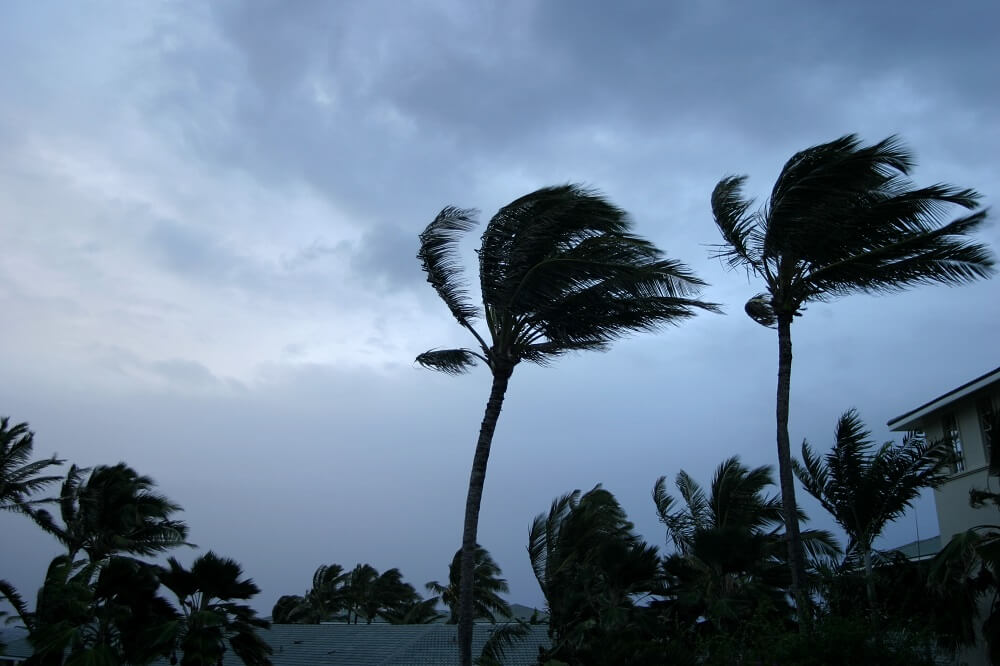What to do during a cyclone

Once a cyclone warning has been declared it is important to keep monitoring the situation and undertake final preparations for the severe weather event.
A final cleanup should be done around the home, making sure any outdoor furniture or loose items are secured or moved indoors.
Swimming pools can be used to submerge plastic outdoor furniture to stop it flying around in high winds while wheelie bins can be filled with water for more stability if unable to be brought indoors.
Vehicles and boats should be secured and moved under shelter.
Unplug all electrical items and turn off electricity and gas main supplies if instructed by authorities.
Fill buckets and baths with clean water in case the water supply becomes restricted.
Secure windows by closing shutters, if you have them, or by taping them in a criss-cross pattern with strong packing tape.
Find out from your local council if your home is in a storm tide evacuation area. If it is, stay with friends or family who live in secure accommodation or an evacuation centre.
Cyclone evacuation centres should only be considered as a last resort. They have very basic facilities and are intended as a short-term shelter.
Contact your local council for more information about your nearest cyclone shelter.
Staying at home is often the best option if you are outside a tidal surge zone, however if you live in a home built before 1982, or have special needs, it may be safer to stay elsewhere.
Consider any special medical needs you may have, such as access to power, clean water (for dialysis) or oxygen.
Make sure you have an evacuation plan and kit.
During a cyclone
- Stay tuned to warnings (keep a battery-powered radio in your emergency kit).
- Activate your emergency plan.
- Stay inside and shelter well clear of windows, doors and skylights.
- Don't use a landline telephone or taps during a severe storm as lightning can travel down phone lines and plumbing.
- If the building starts to break up, shelter in the strongest part (cellar, internal room, hallway or built-in wardrobe) under a mattress, strong table or bench.
Source: Queensland Government
Related topics
Things to note
The information in this article has been prepared for general information purposes only and is not intended as legal advice or specific advice to any particular person. Any advice contained in the document is general advice, not intended as legal advice or professional advice and does not take into account any person’s particular circumstances. Before acting on anything based on this advice you should consider its appropriateness to you, having regard to your objectives and needs.
Insurance Products (excluding Travel Insurance) are issued by RACQ Insurance Limited ABN 50 009 704 152 (RACQI) and arranged by its agent, RACQ Distribution Services Pty Ltd (RDS) ABN 35 116 361 650, AFSL 567130 and RDS' authorised representatives (including RACQ Operations Pty Ltd ABN 80 009 663 414, AR No. 234978 (RACQO). Conditions, limits and exclusions apply. RDS and RACQO are in the RACQ group of companies. One of the companies in the RACQ group of companies has a minority shareholding in RACQI.
RDS and RACQO have not taken your personal objectives, circumstances or needs into account when preparing advice regarding insurance products and you will need to consider whether the advice is appropriate for you. Read the Product Disclosure Statement (PDS) and any applicable Supplementary PDS before making a purchase decision on this product. You can also access our Target Market Determinations on this website. RDS receives a commission from RACQI for the policies it arranges. RACQO receives fees paid for services it provides to RDS. Further details about remuneration are available on request prior to purchasing.
Banking and loan products issued by Members Banking Group Limited ABN 83 087 651 054 AFSL/Australian credit licence 241195 trading as RACQ Bank. Terms, conditions, fees, charges and lending policies apply. This is general advice only and may not be right for you. This information does not take your personal objectives, circumstances or needs into account. Read the disclosure documents for your selected product or service, including the Financial Services Guide and the Terms and Conditions, and consider if appropriate for you before deciding.
Except for RACQ Bank, any RACQ entity referred to on this page is not an authorised deposit-taking institution for the purposes of the Banking Act 1959 (Cth). That entity’s obligations do not represent deposits or other liabilities of RACQ Bank. RACQ Bank does not guarantee or otherwise provide assurance in respect of the obligations of that entity, unless noted otherwise.
RACQ Bank subscribes to the Customer Owned Banking Code of Practice which establishes higher standards than the law requires. The Code reflects modern consumer expectations and developments in approaches to issues such as consumer vulnerability, guarantors, and supporting customers through financial hardship. Please read our Customer Owned Banking Code of Practice page for more information.
RACQ Operations Pty Ltd (ABN 80 009 663 414 AR 000234978) and Members Travel Group Pty Ltd (ABN 45 144 538 803 AR 000432492) are acting as an Authorised Representative of the issuer of the insurance, Tokio Marine & Nichido Fire Insurance Co., Ltd. (ABN 80 000 438 291 AFSL 246 548). Any advice set out above is general in nature only, and does not take into account your objectives, financial situation or needs. Before purchasing any travel products, please consider the RACQ Travel Insurance Product Disclosure Statement (PDS) and the Target Market Determinations (TMDs) that apply to these products. Whilst the PDS outlines the Terms and Conditions of these products, the TMDs outline the intended class of customers that comprise the target market for these travel products. This will allow you to consider which products best suit your objectives, financial situation and needs and consider the products appropriateness to your personal circumstances. TMDs also outline matters involving the distribution and the review of these products. The PDS, Supplementary PDS and TMDs for each travel product can be found here.
